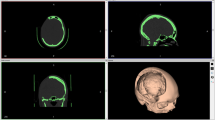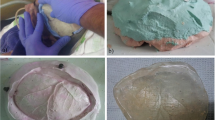Abstract
Cranioplasty is a common neurosurgical procedure. Free-hand molding of polymethyl methacrylate (PMMA) cement into complex three-dimensional shapes is often time-consuming and may result in disappointing cosmetic outcomes. Computer-assisted patient-specific implants address these disadvantages but are associated with long production times and high costs. In this study, we evaluated the clinical, radiological, and cosmetic outcomes of a time-saving and inexpensive intraoperative method to mold custom-made implants for immediate single-stage or delayed cranioplasty. Data were collected from patients in whom cranioplasty became necessary after removal of bone flaps affected by intracranial infection, tumor invasion, or trauma. A PMMA replica was cast between a negative form of the patient’s own bone flap and the original bone flap with exactly the same shape, thickness, and dimensions. Clinical and radiological follow-up was performed 2 months post-surgery. Patient satisfaction (Odom criteria) and cosmesis (visual analogue scale for cosmesis) were evaluated 1 to 3 years after cranioplasty. Twenty-seven patients underwent intraoperative template-molded patient-specific cranioplasty with PMMA. The indications for cranioplasty included bone flap infection (56%, n = 15), calvarian tumor resection (37%, n = 10), and defect after trauma (7%, n = 2). The mean duration of the molding procedure was 19 ± 7 min. Excellent radiological implant alignment was achieved in 94% of the cases. All (n = 23) but one patient rated the cosmetic outcome (mean 1.4 years after cranioplasty) as excellent (70%, n = 16) or good (26%, n = 6). Intraoperative cast-molded reconstructive cranioplasty is a feasible, accurate, fast, and cost-efficient technique that results in excellent cosmetic outcomes, even with large and complex skull defects.



Similar content being viewed by others
References
Alesch F, Bauer R (1985) Polyacryl prosthesis for cranioplasty—their production in silicon rubber casts. Acta Neurochir (Wien) 77:68–71
Andrzejak S, Fortuniak J, Wrobel-Wisniewska G, Zawirski M (2005) Clinical evaluation of the polypropylene-polyester knit used as a cranioplasty material. Acta Neurochir (Wien) 147:973–976
Auguste KI, McDermott MW (2006) Salvage of infected craniotomy bone flaps with the wash-in, wash-out indwelling antibiotic irrigation system. Technical note and case series of 12 patients. J Neurosurg 105:640–644
Bhargava D, Bartlett P, Russell J, Liddington M, Tyagi A, Chumas P (2009) Construction of titanium cranioplasty plate using craniectomy bone flap as template. Acta Neurochir (Wien) 152(1):173–176
Bishop A, Gooch R, Eguchi A, Jeffrey S, Smallwood L, Anderson J, Estevez AG (2009) Mitigation of peroxynitrite-mediated nitric oxide (NO) toxicity as a mechanism of induced adaptive NO resistance in the CNS. J Neurochem 109:74–84
Bruce JN, Bruce SS (2003) Preservation of bone flaps in patients with postcraniotomy infections. J Neurosurg 98:1203–1207
Cabraja M, Klein M, Lehmann TN (2009) Long-term results following titanium cranioplasty of large skull defects. Neurosurg Focus 26:E10
Chen TM, Tsai JC, Burnouf T (2008) Cranioplasty using osteoconductive scaffold and platelet glue. J Trauma 65:1321–1327
Cheng YK, Weng HH, Yang JT, Lee MH, Wang TC, Chang CN (2008) Factors affecting graft infection after cranioplasty. J Clin Neurosci 15:1115–1119
Dashti SR, Baharvahdat H, Spetzler RF, Sauvageau E, Chang SW, Stiefel MF, Park MS, Bambakidis NC (2008) Operative intracranial infection following craniotomy. Neurosurg Focus 24:E10
Dujovny M, Aviles A, Agner C, Fernandez P, Charbel FT (1997) Cranioplasty: cosmetic or therapeutic? Surg Neurol 47:238–241
Eppley BL (2005) Biomechanical testing of alloplastic PMMA cranioplasty materials. J Craniofac Surg 16:140–143
Fathi AR, Marbacher S, Lukes A (2008) Cost-effective patient-specific intraoperative molded cranioplasty. J Craniofac Surg 19:777–781
Fodstad H, Love JA, Ekstedt J, Friden H, Liliequist B (1984) Effect of cranioplasty on cerebrospinal fluid hydrodynamics in patients with the syndrome of the trephined. Acta Neurochir (Wien) 70:21–30
Gladstone HB, McDermott MW, Cooke DD (1995) Implants for cranioplasty. Otolaryngol Clin North Am 28:381–400
Gliese M, Handel G, Brawanski A (2000) A simple and cosmetically ideal method for cranioplasty. Zentralbl Neurochir 61:155–157
Golz T, Graham CR, Busch LC, Wulf J, Winder RJ (2010) Temperature elevation during simulated polymethylmethacrylate (PMMA) cranioplasty in a cadaver model. J Clin Neurosci 17(5):617–622
Gooch MR, Gin GE, Kenning TJ, German JW (2009) Complications of cranioplasty following decompressive craniectomy: analysis of 62 cases. Neurosurg Focus 26:E9
Grant FC, Norcross NC (1939) Repair of cranial defects by cranioplasty. Ann Surg 110:488–512
Grantham EC, Landis HP (1948) Cranioplasty and the post-traumatic syndrome. J Neurosurg 5:19–22
Jankowitz BT, Kondziolka DS (2006) When the bone flap hits the floor. Neurosurgery 59:585–590
Josan VA, Sgouros S, Walsh AR, Dover MS, Nishikawa H, Hockley AD (2005) Cranioplasty in children. Childs Nerv Syst 21(3):200–204
Joseph V, Reilly P (2009) Syndrome of the trephined. J Neurosurg 111:650–652
Kalteis T, Luring C, Gugler G, Zysk S, Caro W, Handel M, Grifka J (2004) Acute tissue toxicity of PMMA bone cements. Z Orthop Ihre Grenzgeb 142:666–672
Kelly ME, Fourney DR, Guzman R, Sadanand V, Griebel RW, Sanche SE (2006) Propionibacterium acnes infections after cranial neurosurgery. Can J Neurol Sci 33:292–295
Kirby BS, Doyle A, Gilula LA (2003) Acute bronchospasm due to exposure to polymethylmethacrylate vapors during percutaneous vertebroplasty. AJR Am J Roentgenol 180:543–544
Kobayashi S, Hara H, Okudera H, Takemae T, Sugita K (1987) Usefulness of ceramic implants in neurosurgery. Neurosurgery 21:751–755
Lee SC, Wu CT, Lee ST, Chen PJ (2009) Cranioplasty using polymethyl methacrylate prostheses. J Clin Neurosci 16:56–63
Li C, Mason J, Yakimicki D (2004) Thermal characterization of PMMA-based bone cement curing. J Mater Sci Mater Med 15:85–89
Liang W, Xiaofeng Y, Weiguo L, Gang S, Xuesheng Z, Fei C, Gu L (2007) Cranioplasty of large cranial defect at an early stage after decompressive craniectomy performed for severe head trauma. J Craniofac Surg 18:526–532
Manson PN, Crawley WA, Hoopes JE (1986) Frontal cranioplasty: risk factors and choice of cranial vault reconstructive material. Plast Reconstr Surg 77:888–904
Marbacher S, Andres RH, Fathi AR, Fandino J (2008) Primary reconstruction of open depressed skull fractures with titanium mesh. J Craniofac Surg 19:490–495
Marchac D, Greensmith A (2008) Long-term experience with methylmethacrylate cranioplasty in craniofacial surgery. J Plast Reconstr Aesthet Surg 61:744–752
Matic DB, Manson PN (2004) Biomechanical analysis of hydroxyapatite cement cranioplasty. J Craniofac Surg 15:415–422
Matic D, Phillips JH (2002) A contraindication for the use of hydroxyapatite cement in the pediatric population. Plast Reconstr Surg 110:1–5
Matsuno A, Tanaka H, Iwamuro H, Takanashi S, Miyawaki S, Nakashima M, Nakaguchi H, Nagashima T (2006) Analyses of the factors influencing bone graft infection after delayed cranioplasty. Acta Neurochir (Wien) 148(5):535–540
Moreira-Gonzalez A, Jackson IT, Miyawaki T, Barakat K, DiNick V (2003) Clinical outcome in cranioplasty: critical review in long-term follow-up. J Craniofac Surg 14:144–153
Nakamura T, Takashima T, Isobe K, Yamaura A (1980) Rapid neurological alteration associated with concave deformity of the skin flap in a craniectomized patient. Case report. Neurol Med Chir (Tokyo) 20:89–93
Odom GL, Woodhall B, Wrenn FR (1952) The use of refrigerated autogenous bone flaps for cranioplasty. J Neurosurg 9:606–610
Rotaru H, Baciut M, Stan H, Bran S, Chezan H, Iosif A, Tomescu M, Kim SG, Rotaru A, Baciut G (2006) Silicone rubber mould cast polyethylmethacrylate-hydroxyapatite plate used for repairing a large skull defect. J Craniomaxillofac Surg 34:242–246
Saringer W, Nobauer-Huhmann I, Knosp E (2002) Cranioplasty with individual carbon fibre reinforced polymere (CFRP) medical grade implants based on CAD/CAM technique. Acta Neurochir (Wien) 144:1193–1203
Staffa G, Nataloni A, Compagnone C, Servadei F (2007) Custom made cranioplasty prostheses in porous hydroxy-apatite using 3D design techniques: 7 years experience in 25 patients. Acta Neurochir (Wien) 149:161–170
Vanaclocha V, Saiz-Sapena N, Garcia-Casasola C, De Alava E (1997) Cranioplasty with autogenous autoclaved calvarial bone flap in the cases of tumoural invasion. Acta Neurochir (Wien) 139:970–976
Winkler PA, Stummer W, Linke R, Krishnan KG, Tatsch K (2000) The influence of cranioplasty on postural blood flow regulation, cerebrovascular reserve capacity, and cerebral glucose metabolism. Neurosurg Focus 8:e9
Yamaura A, Makino H (1977) Neurological deficits in the presence of the sinking skin flap following decompressive craniectomy. Neurol Med Chir (Tokyo) 17:43–53
Yano H, Tanaka K, Matsuo T, Tsuda M, Akita S, Hirano A (2006) Cranioplasty with auto-purified bone flap after infection. J Craniofac Surg 17:1076–1079
Acknowledgments, funding, and disclosure
The authors have no personal, financial, or institutional interest in any of the drugs, materials, or devices described in this article. We are indebted to the radiology technicians from the Institute of Neuroradiology, Bern University Hospital and University of Bern, Bern, Switzerland, for their diligent three-dimensional computer tomography reconstructions. Finally, we are especially grateful for the editorial support of Jeannie Wurz, Department of Intensive Care Medicine, Bern University Hospital, Bern, Switzerland and Susan Wieting, Department of Neurosurgery, Bern University Hospital, Bern, Switzerland.
Author information
Authors and Affiliations
Corresponding author
Additional information
Comments
Siamak Asgari, Ingolstadt, Germany
The authors presented a retrospective study about 27 patients, who underwent one- or two-stage surgery for cranioplasty. Indication for cranioplasty were posttraumatic skull defects (n = 2), resection of tumors with skull involvement (n = 10), and bone flap infection (n = 15). The authors described a method of template-molded PMMA cranioplasty. The authors gave a very detailed analysis of intraoperative characteristics and the postoperative cosmetic results. Altogether, the described cranioplasty procedure is very cost-effective and showed excellent radiological and esthetic results. Finally, the main limitation of this strategy, the autologous bone resorption, was mentioned.
Philippe Bijlenga, Geneva, Switzerland
With more and more decompressive craniectomies performed for different reasons, a simple, safe, quick, and low-cost solution for cranioplasty, as described in this article, is very welcome.
The authors describe a simple method to generate a negative print of the patient’s bone flap that can then be used as a cast to build a Palacos® cement replica. This article shows that the method is not only feasible but also safe and rapid and presented an excellent radiological and cosmetic outcome in 27 patients. The method that is described in this article presents a long list of advantages and a unique limitation that resides in the absolute need of the original patient’s bone flap to serve as a model. Readers are invited to make their own experience and the future will tell us if the technique holds its promises and becomes a worldwide standard.
Rights and permissions
About this article
Cite this article
Marbacher, S., Andereggen, L., Erhardt, S. et al. Intraoperative template-molded bone flap reconstruction for patient-specific cranioplasty. Neurosurg Rev 35, 527–535 (2012). https://doi.org/10.1007/s10143-012-0376-3
Received:
Revised:
Accepted:
Published:
Issue Date:
DOI: https://doi.org/10.1007/s10143-012-0376-3




